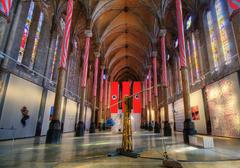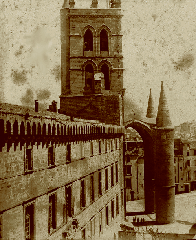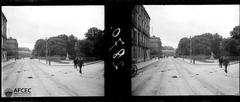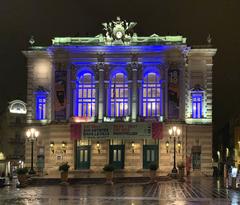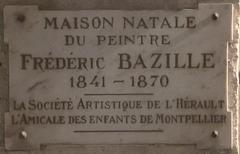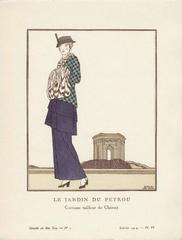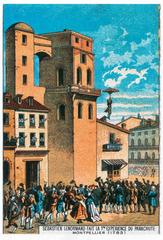Chapelle De La Miséricorde Montpellier: Visiting Hours, Tickets, and Travel Guide
Date: 03/07/2025
Introduction
Located in the historic heart of Montpellier, the Chapelle de la Miséricorde is a compelling destination for those eager to explore the city’s deep-rooted religious, social, and architectural traditions. Founded in 1622 as a response to the city’s siege during the Protestant Rebellion, the chapel has evolved from a charitable initiative by the “Dames de la Charité de la Miséricorde” into a site of cultural and historical significance (fillesdelacharite-province-bfs.fr). Today, it is renowned for its elegant 19th-century architecture, a remarkable collection of religious art, and the last remaining historical pharmacy in Montpellier (patrimoinereligieux34.catholique.fr).
This guide delivers everything visitors need to plan their trip: from detailed visiting hours and ticketing information to historical context, cultural highlights, accessibility, and travel tips. Whether your interests lie in art, history, or the evolution of social care, the Chapelle de la Miséricorde offers a multifaceted and enriching experience (Montpellier.fr; Visit Occitanie).
Table of Contents
- Historical Overview
- Cultural and Artistic Highlights
- Visitor Information
- Practical Tips and FAQ
- Summary and Final Recommendations
- Sources
Historical Overview
Founding and Early Charitable Work
The Chapelle de la Miséricorde was established in 1622 amid the siege of Montpellier, as a charitable response to the crisis. The “Dames de la Charité de la Miséricorde” organized aid for the city’s most vulnerable, combining religious devotion with practical social care. The group’s innovative approach included city-wide divisions for targeted assistance, home medical visits, and the establishment of a pharmacy, which would become renowned for herbal remedies (fillesdelacharite-province-bfs.fr; thetravellersmtp.wordpress.com).
By the late 17th century, the Filles de la Charité, a congregation founded by Saint Vincent de Paul, joined the mission, expanding its reach. Over the centuries, the organization operated an orphanage, school, and a pharmacy, cementing its role in Montpellier’s evolving social welfare landscape.
Architectural Evolution
Initially located on Rue de la Monnaie, the current chapel was constructed in the mid-19th century atop the former mint’s workshops (patrimoinereligieux34.catholique.fr). The building features a single nave, a prominent dome with an oculus, side galleries, and mini-chapels adorned with Pyrénéan marble columns. The interior is rich with 19th-century paintings and significant works by artists including Eugène Devéria and Auguste Barthélémy Glaize, as well as rare 17th-century pieces by Reynaud Levieux.
Social Impact and Legacy
The chapel and its associated institutions played a pivotal role in shaping Montpellier’s model of social care and public health. The pharmacy, staffed by the Sisters, became a center of herbal medicine, and the organization’s structure laid groundwork for future social services (thetravellersmtp.wordpress.com). Despite challenges during the French Revolution and the secularization of charitable institutions, the mission endured, adapting under new frameworks and continuing to serve the city well into the 20th century (fillesdelacharite-province-bfs.fr).
The Miséricorde’s influence also extended internationally, inspiring similar models abroad.
Cultural and Artistic Highlights
More than a religious monument, the Chapelle de la Miséricorde is a repository of regional art and medical history. Notable works include Devéria’s “La Charité de Saint Vincent de Paul,” Glaize’s “Les Dames de la Miséricorde,” and several paintings by Reynaud Levieux (Guide Tourisme France). The adjacent pharmacy showcases over 400 antique jars and implements, reflecting Montpellier’s reputation as a center for medical education (Ministère de la Culture).
Designated a Monument Historique in 2003, the chapel continues to host cultural events, including baroque concerts and educational programs, reinforcing its dual role as a historical and living cultural site (Journées du Patrimoine).
Visitor Information
Opening Hours
- Tuesday to Sunday: 10:00 AM – 6:00 PM
- Closed: Mondays and certain public holidays
Note: Seasonal hours may apply, with winter and summer schedules differing slightly. Always verify on the official website before your visit.
Tickets and Admission
- Individual Admission: Free
- Group Visits (20+): €2 per person
- Combined Ticket (Histoire et Patrimoine circuit): €3, valid for one week and grants access to other participating museums (Guide Tourisme France)
Discounts and free entry are available for visitors under 26, over 60, job seekers, and school groups. Check current offers and combined ticket options for the best value.
Accessibility
The site is partially accessible:
- Wheelchair Access: Ramps available for most areas; some historic spaces may present challenges.
- Facilities: No on-site restrooms or café; amenities are available nearby in the old town.
For special needs or assistance, contact the site ahead of your visit.
Getting There
- Address: 1 rue de la Monnaie, 34000 Montpellier
- Public Transport: Close to the Gare St Roch tram and bus stops. The site is a short walk from Montpellier-Saint-Roch train station.
- Parking: Limited in the old town. Use public garages and walk to the site.
Guided Tours and Events
- Guided Tours: Available for groups (by reservation, €2 per person). Individual visitors can explore independently with interpretive panels (primarily in French).
- Special Events: The chapel hosts concerts, cultural events, and is featured during European Heritage Days and the Night of Museums. Check the official website for schedules.
Nearby Attractions
Combine your visit with other top Montpellier sites:
- Musée Fabre
- Place de la Comédie
- Saint-Pierre Cathedral
- Jardin des Plantes
- The medieval Mikvé
Interactive maps and virtual tours are available on the Visit Occitanie and Montpellier tourism websites.
Practical Tips and FAQ
Q: Is there an entrance fee?
A: Individual admission is free. Groups may pay a nominal fee; combined tickets are available.
Q: Is the chapel accessible for visitors with limited mobility?
A: There is partial wheelchair access; some areas may be difficult due to historic architecture.
Q: Are guided tours available?
A: Yes, for groups by reservation; individuals visit independently.
Q: Can I take photos?
A: Photography is permitted, but please respect signage and staff instructions.
Q: What language are the materials in?
A: Most interpretive panels are in French—consider a translation app if needed.
Q: Are there restrooms or a café on-site?
A: No, but facilities and dining options are available nearby.
Summary and Final Recommendations
The Chapelle de la Miséricorde is far more than a religious site; it is a living symbol of Montpellier’s traditions of charity, community resilience, and cultural preservation. Visitors can explore exquisite artworks, the historically significant pharmacy, and the inspiring stories of the women and Sisters who shaped social welfare here (fillesdelacharite-province-bfs.fr; patrimoinereligieux34.catholique.fr). Its integration into the city’s museum circuit, accessible location, and affordable entry make it an unmissable destination for anyone visiting Montpellier (Guide Tourisme France; Montpellier.fr).
For an optimal experience, plan ahead:
- Check current opening hours and events
- Consider a guided tour for deeper insight
- Use digital resources like the Audiala app for audio guides
- Combine your visit with nearby historical attractions
Your exploration of the Chapelle de la Miséricorde is not only a journey through centuries of history and art but also a chance to connect with the spirit of compassion and cultural legacy that defines Montpellier (Journées du Patrimoine).
Sources
- fillesdelacharite-province-bfs.fr
- patrimoinereligieux34.catholique.fr
- thetravellersmtp.wordpress.com
- Guide Tourisme France
- Ministère de la Culture
- Visit Occitanie
- Montpellier.fr
- Journées du Patrimoine
